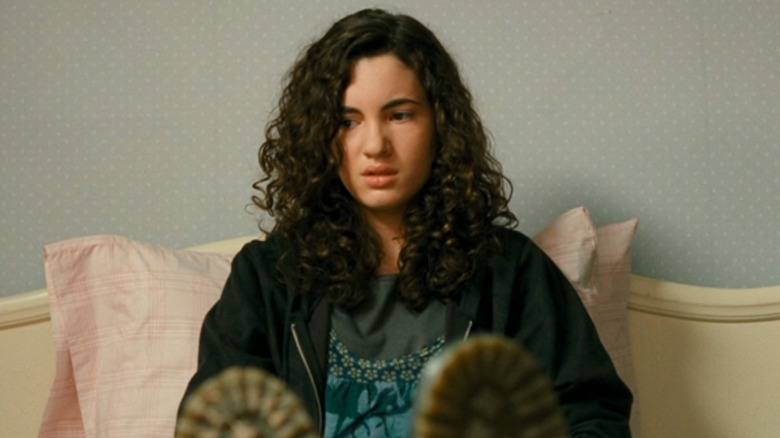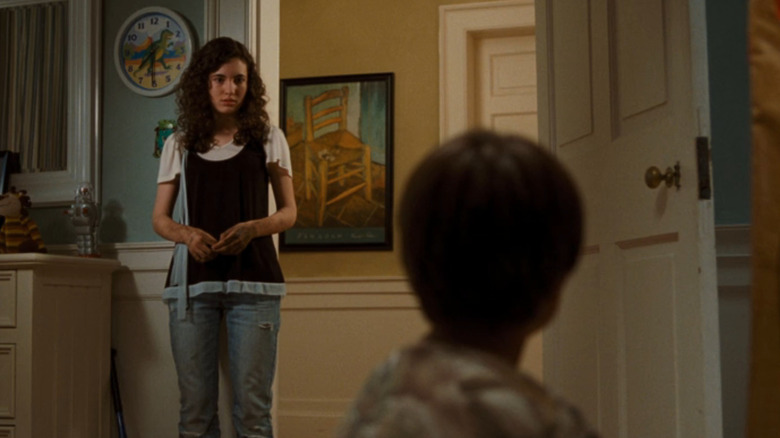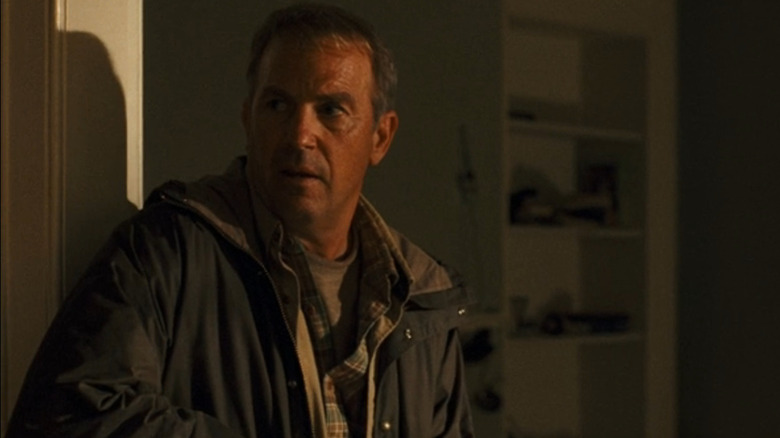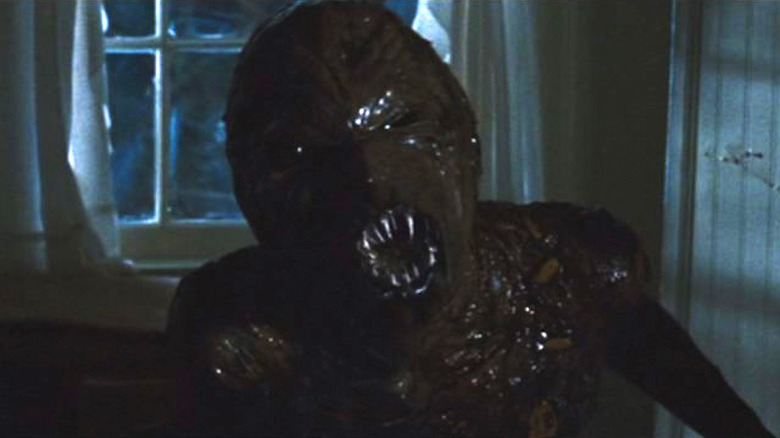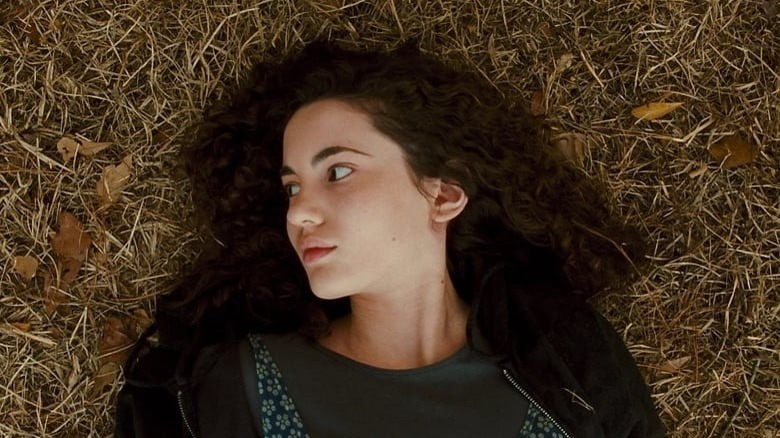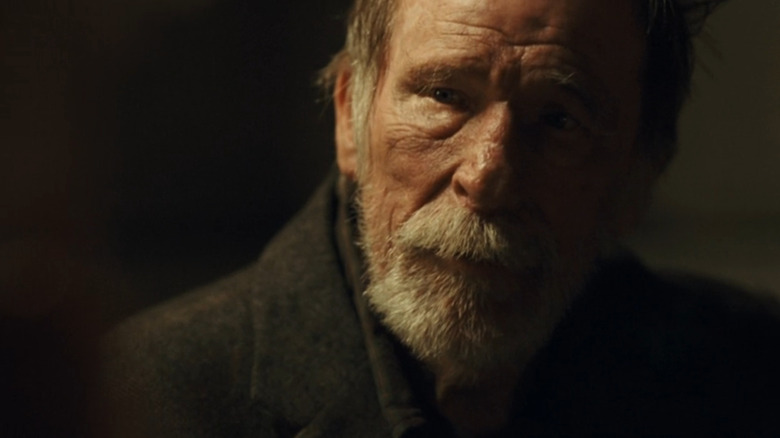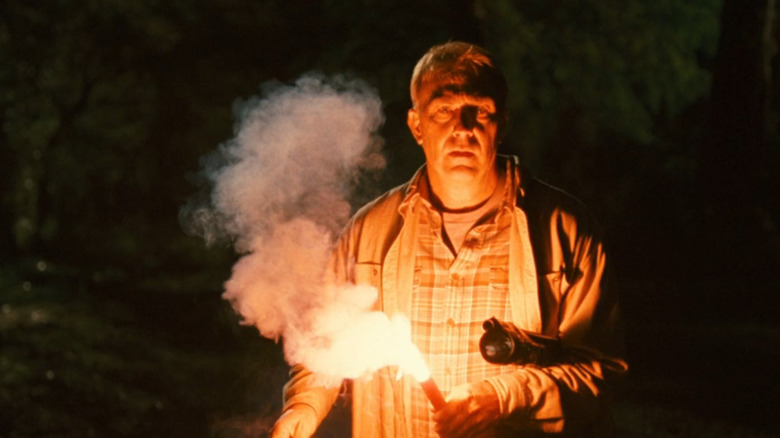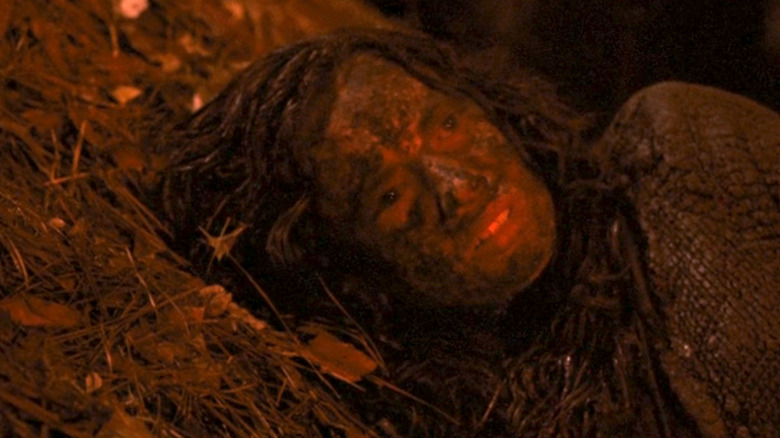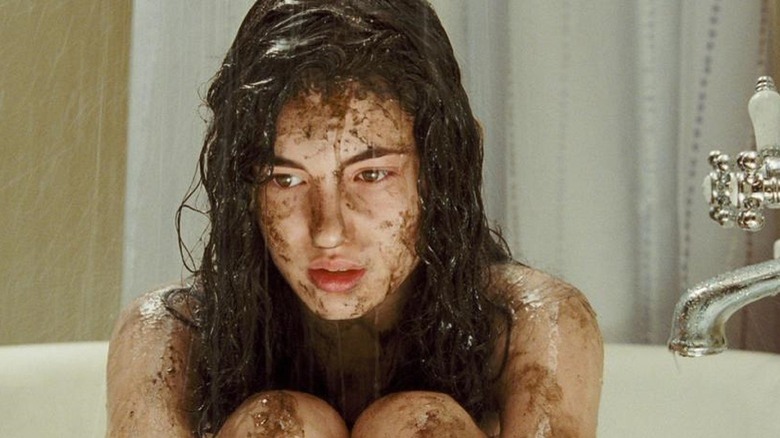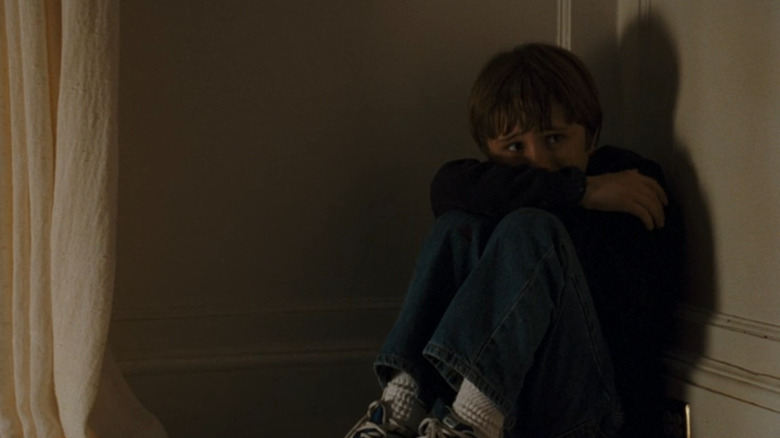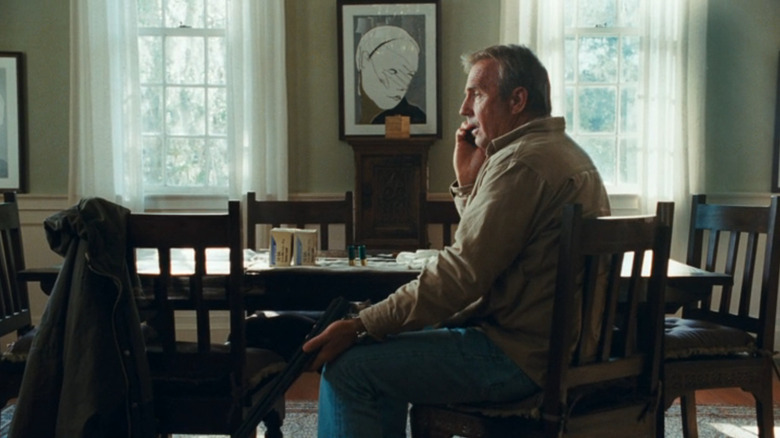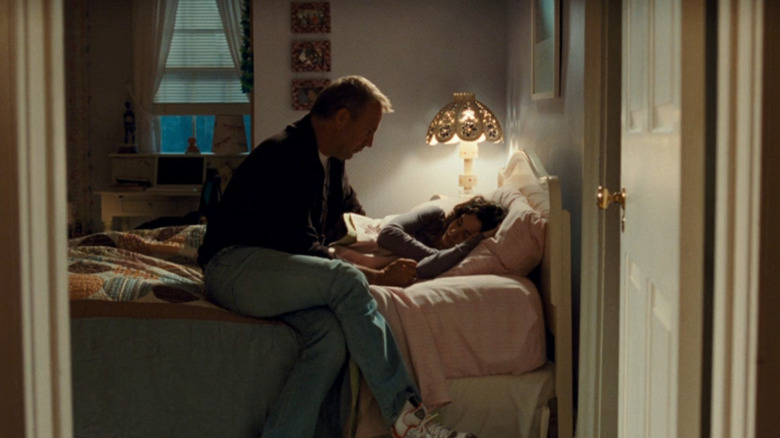The Ending Of The New Daughter Explained
Based on a short story from horror writer John Connolly, "The New Daughter" is a supernatural thriller starring Kevin Costner and Ivana Baquero released in 2009. Though it was a major bomb in theaters at the time and was forgotten for more than a decade, the film has received renewed attention in recent years. Perhaps due to Costner being back on people's radars following his leading role in the smash hit TV series "Yellowstone," or perhaps because of the film's more recent presence on streaming, new audiences have been checking out "The New Daughter."
Costner plays John James, a man who relocates his two children to a new town after an unexpected divorce. In their new home, daughter Louisa (Baquero) exhibits unusual changes in her behavior that John first attributes to the recent upheavals in her life. Soon, however, he realizes that something far more disturbing is going on.
A suspenseful drama about family, and what it takes to keep it together, "The New Daughter" ends on a surprising and dark note. Full of unexpected revelations and deeper meaning, there's a lot more to the film than what you might see on the surface. When it all concludes, you might still be left with a few questions, so here's the ending of "The New Daughter" explained.
What you need to know about the plot of The New Daughter
At the beginning of the film, John James and his two children — middle-schooler Louisa and her little brother Sam (Gattlin Griffith) — have just moved into a new home after his wife abandoned the family. While John struggles to balance being a single father with his work as a novelist, Louisa becomes fascinated by a large burial mound on the property that gives Sam the creeps. Before long, Louisa spends all her time out on the mound, and her behavior becomes increasingly disturbing, too. She seems to be responsible for breaking the arm of a fellow student and often comes home inexplicably covered in mud.
After John discovers his daughter with a bizarre straw doll, he decides to take matters into his own hands and looks into the history of the house and the property. In his search for answers, John learns that the house has a dark and twisted past, and its previous owners disappeared under unexplained circumstances. Digging further, John finds out that the mound may be part of an ancient race of beings some call "mound-walkers," and that they may be preying on his daughter to survive.
During John's investigation, his trusted babysitter (Sandra Ellis Lafferty) is murdered by the unseen mound-walkers who are trying to get to his children. Now it's a race against time to destroy the mound and save his daughter from being consumed by an ancient evil.
What happened at the end of The New Daughter
Despite being skeptical about the notion of ancient evils, John takes every precaution and attempts to have the mound bulldozed. During the process of removing it, the body of the babysitter is uncovered and John is accused of her murder. After the officer who takes him into custody is dragged away by the mound-walkers, John takes it upon himself to end the threat once and for all.
Rushing to try and save his children John discovers that his daughter has murdered her school teacher Ms. Parker (Samantha Mathis) and is preparing to become the new queen of the mound-walkers. With a shotgun in hand, John follows his daughter into the catacombs under the mound and drags her out, only to watch as her body slowly succumbs, and she transforms into one of the decrepit ancient entities. Unable to allow her to become one of the mound-walkers, John is forced to take drastic action. He sets the entire mound ablaze, apparently killing himself and his daughter in the process.
From afar, Sam watches in horror but believes he sees his father walking towards him, and the audience can see the reflection of an unknown figure in the framed photograph he's holding. Sam looks up in hope that his father has survived, but the final shot of the film shows a group of mound-walkers surrounding him, as the terrifying growls of the creatures fill the night air.
What did the creatures really want?
When Professor Evan White (Noah Taylor) arrives to stop John from destroying the mound, we learn more about the strange beings who call it their home. The mound-walkers are twisted, monstrous, human-like beings who appear as living corpses. They are ferocious animalistic creatures that kill and mutilate their prey with their bare hands and sharp teeth.
According to Professor White — who is the foremost authority on this ancient evil — the mound-walkers are an all-male species that has just a single queen for the reproduction of their species. Thousands of years ago, they were worshipped as gods by an ancient civilization that would often give them gifts — in the form of small straw dolls — while the mound-walkers searched for a new queen. However, it seems the mound-walkers have been without a leader for quite some time, and have been dormant as a result. When John and his family move in, they zero in on Louisa as their new leader, believing that she is the perfect young, innocent human girl to serve their needs.
Now that they've found her, the mound-walkers plan to use Louisa to increase their number, destroy the human race, and take over the entire planet, claiming it for themselves. Though the mound on John's property is not the only one, it seems to be the only place where the mound-walkers have re-awakened, and Louisa's transformation into their queen could spell the end of all humanity.
What really happened to Louisa?
Louisa undergoes plenty of struggles in "The New Daughter." She is faced with a new life after her mother abandons her while also dealing with the many changes of adolescence. But after the mound-walkers take her, she becomes even more disturbed, as the creatures use her for their own ends. Perhaps surprisingly, though, the changes in Louisa that take place in the film aren't always clear.
Following her first encounter with the mound itself, Louisa becomes darker, stranger, and more sinister. She's repeatedly found caked in mud and later is seen digging in the dirt with her hands. She's even seen attempting to ominously lure her brother out to the mound, presumably so he could be eaten by the mound-walkers. John discovers a large pile of dirt in Louisa's closet, too, and while the obvious conclusion is that Louisa has been corrupted by the mound-walkers, that's just one possible explanation.
Another is that the real Louisa was kept inside the mound, and a duplicate — one of the creatures in her form, similar to the Native American legend of skin-walkers — was who we saw for most of the film, sent out into the world looking for food for the mound-walkers. In the end, when John goes inside the mound, he could be rescuing the real Louisa. Either way, the result is the same: Louisa begins to fully transform into a mound-walker when her father finds her, and he's forced to save her soul by killing her.
The truth about Roger Wayne and his family
When John first moves into his new home with Louisa and Sam, he encounters a few strange occurrences right away. His son Sam, for instance, discovers a rifle hidden in an antique piano that had been left by the previous tenants. And when he goes to pick up supplies at a nearby store, the shopkeeper and his wife seem visibly disturbed to learn he's bought that particular house. They mention that the home has an unsettling history, with urban legends about an incident involving a mother and daughter, though it's not clear what happened to them.
Eventually, John's investigation into the history of the house leads him to Roger Wayne (James Gammon), the former homeowner. Roger tells him that years earlier his granddaughter Emily had begun behaving strangely — just like Louisa — and her mother Sarah locked her in a room and ran off, never to be seen again. When Roger discovered Emily locked away, he realized she was no longer his granddaughter, and he knew the mound was to blame.
We see hints of this past early in the film. When Louisa is first exploring their new home, she walks across dried muddy footprints in the hallway, the same kind she would later leave after being possessed by the mound-walkers. So what happened to Emily? According to Roger, he was forced to do the one thing his daughter couldn't, and kill his granddaughter. Starting a fire, he burned her alive, saving her immortal soul.
Did John sacrifice his life at the end of The New Daughter?
At the end of "The New Daughter," John grabs a shotgun and some flares from the patrol car of Officer Lowry (Erik Palladino), who'd been killed by the creatures as he was taking John back to the house. Determined to end the threat once and for all, John prepares for battle but realizes too late that there is no way for him to save his daughter. All he can hope for is to save her soul and stop the mound-walkers from escaping and propagating their species. The question is, does he succeed?
While John does successfully detonate a barrel of gasoline, setting the entire mound ablaze, it's never definitively said if this halts the creatures' plans. We don't even know if it kills Louisa — their new queen — or if John survives. We're led to believe at first that John has indeed made it out alive, with Sam thinking he sees his father emerging from the flames, but it's suggested this could have been one of the mound-walkers. Ultimately, "The New Daughter" is left on an ambiguous note, with the final resolution left up to the viewer — or perhaps a possible sequel — to determine what happened.
If John did die in the blaze, however, it would prove that he — like Roger Wayne — would do anything for his daughter, and fulfill his promise to never leave her side ... even in death.
What did the ending of The New Daughter mean?
When Louisa is taken over by the mound-walkers, it's more than just a young girl being used as a receptacle for evil. Her being is repurposed by these demonic creatures to become their new queen, and the all-male species that were once worshipped as powerful deities will use her to create untold numbers of new offspring. This parallels another minor subplot, as Louisa's brother Sam is given an ant farm in school by his teacher, Ms. Parker, and is told how they — like the mound-walkers — have a single queen whom they all serve.
As for John, he has spent the entire film unable to reconcile his new role as a single parent, fearing he will let his children down. But in an ironic, twisted way, when he finds the strength to set the mound on fire — presumably killing Louisa in the process — he is finally able to prove that he will do anything to protect his children ... even the very worst thing. Though he can't save her Earthly life once she'd been taken by the mound-walkers, he can save her soul, even if it means sacrificing himself in the process.
What were the themes of The New Daughter?
From the very beginning of "The New Daughter," it's clear that there are deeper themes at play than just a ghostly haunting or a supernatural evil. Newly single father John James is still reeling from his wife leaving him high and dry, while his kids are trying to make sense of their new life without their mother. Ultimately, this is a movie that's as much about parenting and growing up as it is about the mound-walkers' search for a new queen.
Louisa's demonic changes, under the influence of the mound and its ancient evil beings, can easily be seen as an allegory for adolescence, too. Just as the mound-walkers seem to push her into acting out and behaving strangely, so too does puberty force young people into uncomfortable changes that alter their behavior in ways that confuse and frustrate the adults around them. In this case, though, the changes are unexplainable and are the result of an evil, outside force.
Given John's insecurities regarding his parenting, the film can also be seen as a statement on how our drive to do right by our families can lead us to dig for answers to questions that confound us. In John's case, it's literal, as he must dig through an ancient burial mound, but for the rest of us, it's symbolic of the quest for truth in how best to care for our loved ones.
What does the ending of The New Daughter mean for the future?
Produced in 2009, "The New Daughter" is nearly 15 years old, and there has never been word of a sequel. While a follow-up remains unlikely at best, that doesn't mean we can't speculate on what could happen next. After all, with Sam being approached by someone who he believes is his father, and surrounded by evil mound-walkers who may be more powerful than ever, there's plenty of stories left to be told.
That said, what happens after the end of "The New Daughter" hinges greatly on what went down when John ignited the fire at the mound. If he died and killed Louisa in the process, then the mound-walkers may be looking for vengeance — as well as a new innocent girl to make their queen. But if he failed, and Louisa lives, it could mean an all-out invasion by the mound-walkers, whose numbers could increase with the help of their new queen.
Of course, there's also the matter of the other mounds around the world. Could the arrival of Louisa as their new queen — even if briefly — have awakened them from slumber, and catalyze a new war between the mound-walkers and humanity?
How an alternate ending to The New Daughter would have changed everything
The ending of "The New Daughter" we got to see is indeed the only one that was ever filmed by director Luis Berdejo. Nevertheless, there are two other, alternate endings, the first of which is the conclusion of the original short story, which is markedly different than the film. Written by John Connolly, the story ends with a lot more unanswered questions, some as fundamental as whether any of it actually happened. It's implied that the events witnessed could have been a dream, or otherwise in Louisa's head, making it a much more tangible allegory for adolescence.
Later, when the story was adapted into a feature film script, a different ending was written that Berdejo made changes to before filming. According to the director, the original script closed out the story on a much less vague note, with more concrete answers. "In the original ending of the script, you could see how John James was walking through the flames, after the explosion of the mound, carrying Louisa in his arms," Berdejo told The Lovecraft eZine. "I found that pretty unbelievable and a bit cheesy," he added. In the end, the filmmaker went for something in between the conclusive ending of that script and Connolly's original ambiguous ending. "We came up with the idea of the kid holding the family picture by the fence, and the 'indeterminate shape' on its reflection, so the film didn't fully telegraph a happy ending."
What did the director have to say about the filmed ending of The New Daughter?
Believe it or not, "The New Daughter" wasn't initially envisioned as the kind of jump-scare-filled horror movie that it became. As originally conceived by the director, it was going to be more of a drama, with the horror elements in the background. As filming concluded, however, things began to change. "During the editing we realized that if the movie was going to be marketed as a supernatural thriller, the audience might feel that it was taking too long to see those elements on screen, so we came up with the idea of putting a creature on the roof of the house on minute nine," Berdejo said to The Lovecraft eZine. "That creature totally sells that you are watching a supernatural film."
When it comes to the ending, Berdejo also made a tonal shift from the original story. "We then realized that the darker the ending was, the more surprising the movie looked like, since it had started as an unusual family drama," he explained. This left him with a decision to make in post-production, and just how truly scary he wanted the ending to be, with a sense of pure dread for what would follow. "That's when we added the three monsters behind Sam climbing down the house and the tree." This removed any possibility of a happy ending, which Berdejo felt would give the film's conclusion a more frightening and memorable final shot, but also debate among viewers and critics. "The ending brought surprise and discussion, which I think is great."
